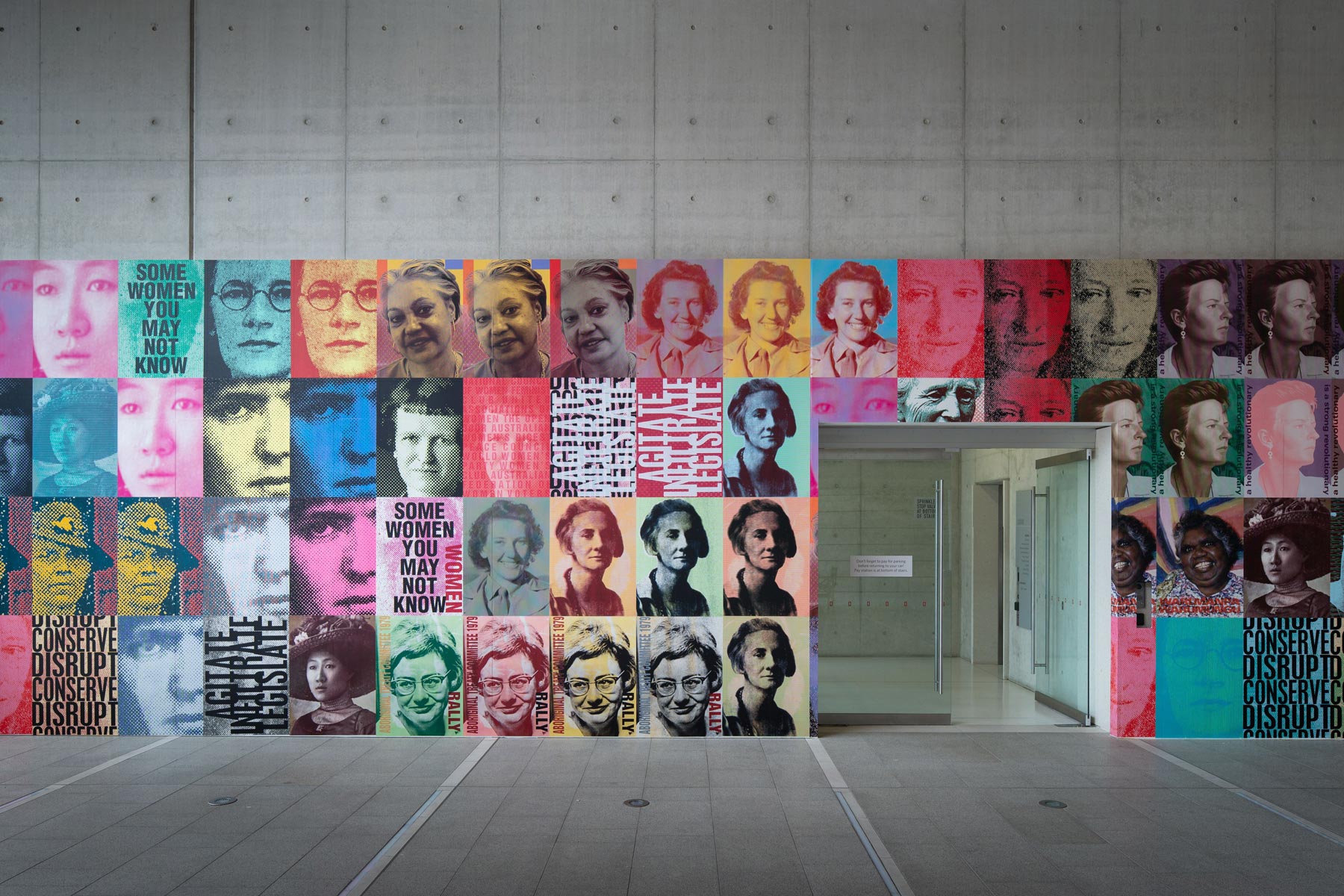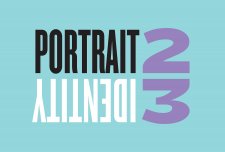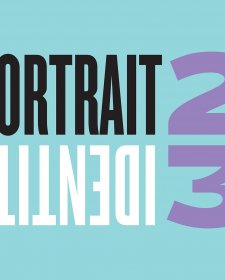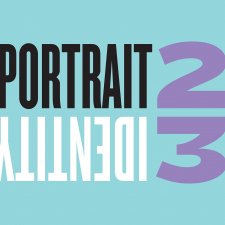‘Everybody’s lives are built by so many influences, and for me, it is writers, artists and activists who have influenced how I think about the world. This work includes 116 screenprinted posters featuring 15 women: Doris Alder, Marie Byles, Pearl Mary Gambanyi Gibbs, Muriel Heagney, The Hon Rose Jackson, Kate Jennings, Peggy Napangardi Jones, Mandy Martin, Bertha McNamara, Maude Nomchong, Frances (Budden) Phoenix, Katharine Susannah Prichard, Barb Shaw, Jessie Street and Judith Wright.
In my early life it was posters that informed me about what was happening outside of the mainstream – about protest, action, events and issues. I love the ephemeral nature of posters. Often it is visual art that was made to be temporary that provides a far stronger picture of what was happening at a particular time than something created for posterity.’ - Alison Alder
English-as-a-second-language and primary school teacher Doris Alder (née Young) (1917–1996) was a passionate bushland regenerator and gardener. Living on a battle-axe block purchased as part of a strategy to preserve Sydney’s remnant bushland, Alder raised her two daughters to respect the natural world and embrace feminist ideals of equality and social justice.
Portrait source: Doris Young in her Land Army uniform, Tamworth c. 1942 by Reg Alder
Solicitor, bushwalker, mountaineer and conservationist Marie Byles (1900–1979) was the first woman permitted to practice law in New South Wales and helped change legislation that discriminated against women’s rights in marriage and divorce. Also committed to the preservation of the Australian environment, Byles heavily petitioned the government to reserve vast areas of land for future generations and encouraged fellow members of the Sydney Bushwalkers, like Alder’s father Reg Alder, to purchase and conserve remnant bushland in suburban Sydney.
Portrait source: Portrait of Maria Byles by an unknown photographer, University of Sydney Archives
Pearl Mary Gambanyi Gibbs (1901–1983), belonging to the Ngemba or Muruwari language groups through her mother, was a tireless and prolific Aboriginal rights activist. She joined the fledgling Aborigines Progressive Association in Sydney in 1937, taking on a prominent public speaking and advocacy role. A member of Union of Australian Women and the Committee for Aboriginal Citizenship, she assisted with the organisation of the Day of Mourning protest on Australia Day in 1938 (where this image was taken), and served on the Council for Aboriginal Rights.
Portrait source: Aborigines day of mourning, 26 January 1938 by C Sorrell, Man Magazine, March 1938, p 108, Mitchell Library, Printed Books Collection, Q 059/9
Muriel Heagney (1885–1974) was an Australian trade unionist, Labor Party member, feminist and equal pay campaigner. A member of several key organisations including the Workers’ Educational Association and Unemployed Girls’ Relief Movement, Heagney undertook research on equal pay issues for the Federated Unions of Australia, the Clothing Trades Union and the Open Door Council, publishing Are Women Taking Men’s Jobs? In 1937 she helped found the Council for Action for Equal Pay. Heagney died in 1974, one week after the National Wage Case decision granted women an adult minimum wage.
Portrait source: ‘Lifelong Fight for Equal Pay’, The Sun, Sydney, 24 July 1941, p 13, Trove, National Library of Australia
The Hon Rose Jackson (b. 1984) is a Member of the Legislative Council of NSW and Shadow Minister for Water, Housing and Homelessness. A feminist, unionist, Labor politician and community activist, Jackson holds degrees in law and economics and is a voice for young women and working parents in the NSW Parliament. In 2019 she was elected President of the Evatt Foundation, which fights for social justice, equality, democracy and human rights.
Portrait source: Screenshot of proceedings in the NSW Legislative Assembly, 6 May 2022, 5.36pm
Poet, essayist, memoirist, novelist and feminist Kate Jennings (1948–2021) is infamous for her Anti-Vietnam War protest speech at a rally in 1970 when she was 21 and often credited with starting the second-wave feminist movement in Australia, influencing the next generation of feminists like Alder. She was also instrumental in opening the first women’s refuge for victims of domestic violence. Her best-known novels Snake (1996) and the multi-award-winning Moral Hazard (2002) were both named New York Times Notable Book of the Year.
Portrait source: Kate Jennings by Sue Jones, published in Kate Jennings, Come to me my melancholy baby, Outback Press, Fitzroy, 1975, p 3
Celebrated Warlmampa and Warumungu artist Peggy Napangardi Jones (1951–2014) joined the Julalikari Women’s Arts & Crafts program in Tennant Creek in 1996, where she explored diverse painting and printmaking techniques, developing her distinctive bold and colourful style. Alder worked alongside Napangardi Jones during her year-long Australia Council Fellowship at Julalikari in 1996–97. Their collaboration culminated in a joint exhibition Kujjura Mampaly Nyirrila (Two Together), exhibited in Tennant Creek, Alice Springs and Canberra. Napangardi Jones’ artwork has been exhibited and collected nationally and internationally.
Portrait source: Portrait of Peggy Napangardi Jones by Paul Cockram
Polish-born socialist agitator and feminist Bertha McNamara (1853–1931) published Home Talk on Socialism (1891), one of the earliest socialist pamphlets produced in Australia. She later opened a bookshop in Sydney’s Castlereagh Street, which became a renowned meeting place for radical thinkers, activists and creatives. McNamara was a leading figure in the Social Democratic Federation of Australasia, the Womanhood Suffrage League of NSW and the Labor Party, as well as being the mother-in-law of Henry Lawson and JT Lang.
Portrait source: ‘The World of Women’, The Labor Daily, 28 July 1931, p 7, Trove, National Library of Australia
Painter, printmaker and teacher Mandy Martin (1952–2021) studied at the South Australian School of Art. From 1978 to 2003 she lectured at the School of Art at the Australian National University introducing students, including Alder, to the idea of art as a powerful tool for social change. A passionate environmentalist, much of Martin’s work was motivated by the ‘urgency to address the major issues of land use and exploitation in Australia’. She held over 100 solo exhibitions during her career, and her paintings are held in many public and private collections.
Portrait source: Portrait of Mandy Martin by Dianna Wells
Painter and needleworker Maude Nomchong (1889–1966) studied bookkeeping and assisted with the management of her family’s businesses. Her father, Chee Dock Ng, settled in Mongarlowe in 1877, not far from the studio where Alder printed this portrait. In 1884 he opened a general store in Braidwood – locals called the family by the name of the shop ‘Nomchong’, meaning ‘southern prosperity’. Maude’s renown as a talented needlewoman and painter is recorded in Joan Kerr’s Heritage: The national women’s art book, 500 works by 500 women artists from colonial times to 1955.
Portrait source: Portrait of Maude Nomchong of Braidwood, NSW by an unknown photographer, National Library of Australia, PIC/7658
Artist and feminist Frances (Budden) Phoenix (1950–2017) was one of the founders of the Women’s Domestic Needlework Group, which aimed to elevate and promote women’s craft work and staged The D’Oyley Show: An exhibition of women’s domestic fancywork in 1979. As Alder wrote in the National Gallery of Australia’s Know My Name (2021) catalogue: ‘to my eyes, as a second‑year student at a regional art school, the work was both revolutionary and revelatory.’
Portrait source: Trespassers 1992 by Frances (Budden) Phoenix. Courtesy Sally Cantrill
Writer and political activist Katharine Susannah Prichard (1883–1969) began her literary career as a journalist and published many significant novels. After establishing a local labour study circle, Prichard became a foundation member of the Communist Party of Australia in 1921, questioning the social injustices between rich and poor, black and white, city and country. As a young woman working in the Northern Territory, Alder read one of Prichard’s early, major novels, Coonardoo: The Well in the Shadow (1929), a comment on the impact of colonisation on Aboriginal women.
Portrait source: Perth Daily Mail, 26 September 1929
Barb Shaw (b. 1952), born to a Kaiditch mother from Central Australia, lives in Tennant Creek, NT. During her career she was an elected ATSIC representative, CEO of Anyinginyi Health Aboriginal Corporation, Chair of the Aboriginal Medical Services Alliance NT and President of Barkly Regional Council, among many other roles. Her calm and forceful advocacy on behalf of her community, combined with an ethos of inclusivity which encouraged new settlers in the region to listen and learn, assisted the development of many groundbreaking programs and reforms in Tennant Creek.
Portrait source: Anyinginyi Health Aboriginal Corporation 2002–03 Annual Report
Activist and feminist Jessie Street (1889–1970) was heavily involved in campaigning for women’s rights from the 1920s, fighting for equal status and opportunity for women. In 1945, she was the sole Australian woman delegate to the founding of the United Nations. Alongside this, Street rallied for the peace movement and, with her longstanding commitment to the elimination of discrimination against First Nations peoples, played a pivotal role in the campaign for the 1967 Referendum.
Portrait source: Photograph of Jessie Street as a young woman c. 1920 by Judith Fletcher, National Library of Australia, nla.obj-231550978
Poet, conservationist and Aboriginal land rights campaigner Judith Wright (1915–2000) is one of Australia’s most celebrated literary voices. Wright co-founded the Wildlife Preservation Society of Queensland and campaigned to protect the Great Barrier Reef. In 1979 she helped establish the Aboriginal Treaty Committee, advocating for a Treaty between the Commonwealth Government and Aboriginal representatives. The committee commissioned artist Colin Little to design a screenprinted poster, which Alder helped to print as one of her first jobs as a young artist working at Megalo Print Studio in Canberra.
Portrait source: Judith Wright, Because I was Invited, Oxford University Press, Melbourne, 1975 (cover image)














